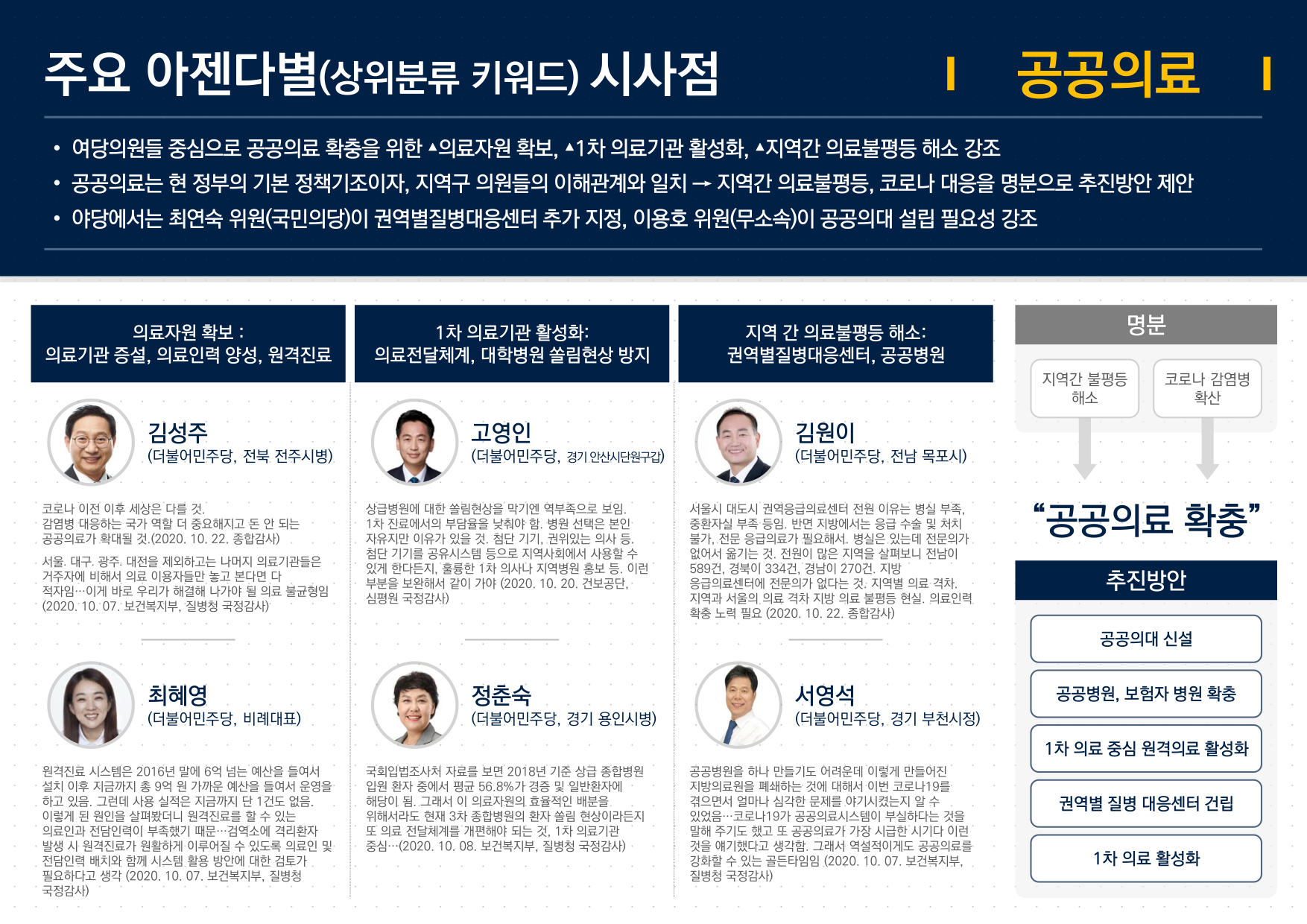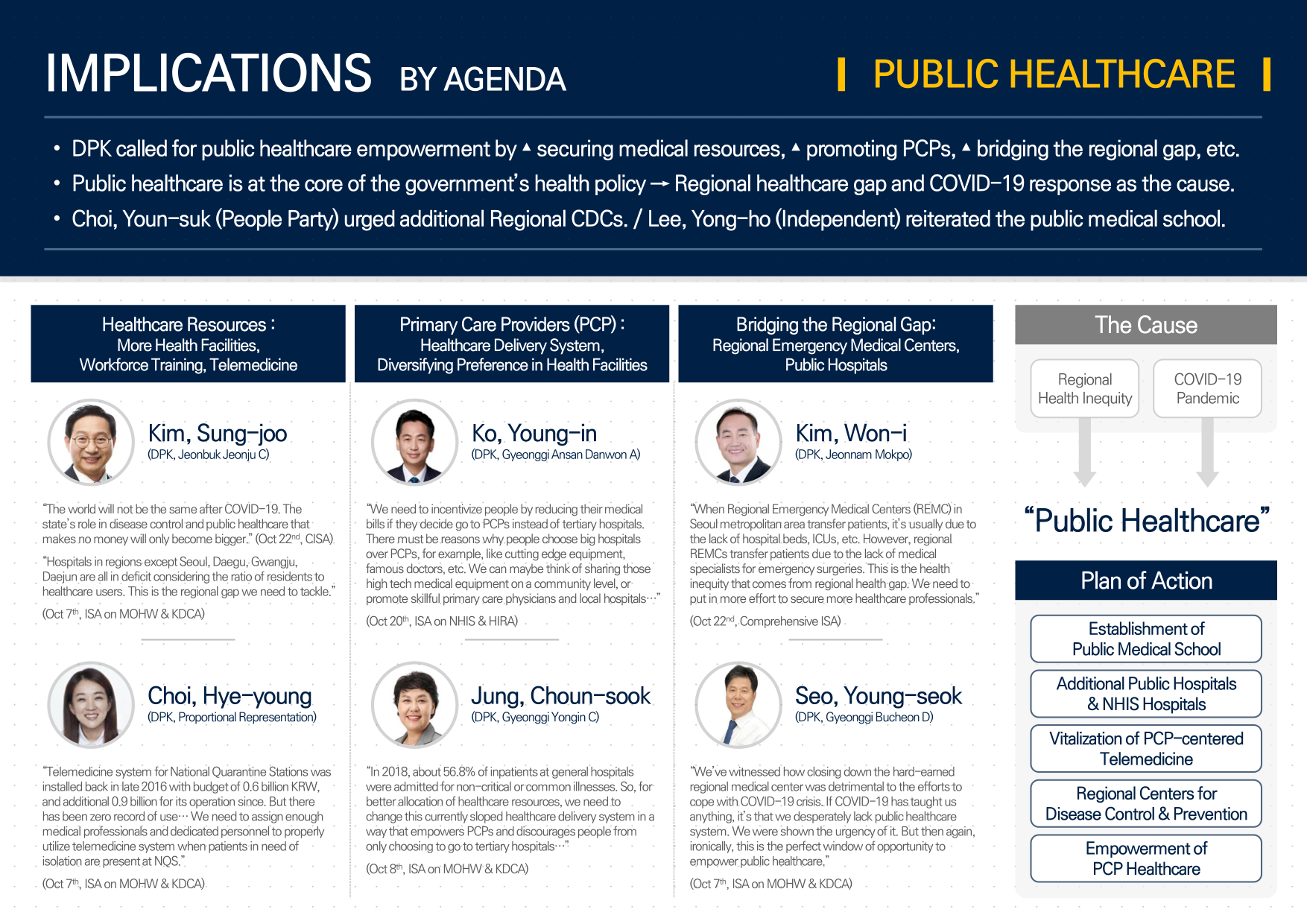ISA Report Translation [Korean → English]

The following pages are a part of the report on the National Assembly (NA) Health & Welfare Committee(HWC)’s annual Inspection of State Administration (ISA) that utilized big data analytics method to extract implications from the huge amount of information pouring out during the ISA season.
다음은 대한민국 국회 보건복지위원회의 국정감사 시즌 쏟아져 나오는 방대한 양의 정보를 빅데이터 분석기법을 활용하여 처리하고 시사점을 도출하고자 한 보고서에서 발췌된 일부입니다.
The report was first prepared in Korean and then translated into English.
보고서는 먼저 한글로 작성된 후 영문으로 번역되었습니다.
여당의원들 중심으로 공공의료 확충을 위한 ▴의료자원 확보, ▴1차 의료기관 활성화, ▴지역간 의료불평등 해소 강조
→ The ruling party called for public healthcare empowerment by ▴ securing medical resources, ▴ promoting primary care providers (PCP), ▴ bridging the regional gap, etc.
공공의료는 현 정부의 기본 정책기조이자, 지역구 의원들의 이해관계와 일치 → 지역간 의료불평등, 코로나 대응을 명분으로 추진방안 제안
→ Public healthcare is at the core of the government’s health policy and in alignment with interests of NA Members → Regional healthcare gap and COVID-19 response mentioned as cause for the push.
야당에서는 최연숙 위원(국민의당)이 권역별질병대응센터 추가 지정, 이용호 위원(무소속)이 공공의대 설립 필요성 강조
→ Among the opposition, Choi, Youn-suk (People Party) urged for additional Regional Centers for Disease Control and Lee, Yong-ho (Independent) reiterated the need for public medical school.
의료자원 확보 : 의료기관 증설, 의료인력 양성, 원격진료
→ Healthcare Resources : More Health Facilities, Workforce Training, Telemedicine
“코로나 이전 이후 세상은 다를 것. 감염병 대응하는 국가 역할 더 중요해지고 돈 안 되는 공공의료가 확대될 것. … 서울․대구․광주․대전을 제외하고는 나머지 의료기관들은 거주자에 비해서 의료 이용자들만 놓고 본다면 다 적자임…이게 바로 우리가 해결해 나가야 될 의료 불균형임.”
→ “The world will not be the same after COVID-19. The state’s role in disease control and public healthcare that makes no profit will only become bigger. … Hospitals in regions except for Seoul, Daegu, Gwangju, Daejun are all in deficit considering the ratio of residents to healthcare users. This is the regional gap we need to tackle.”
“원격진료 시스템은 2016년 말에 6억 넘는 예산을 들여서 설치 이후 지금까지 총 9억 원 가까운 예산을 들여서 운영을 하고 있음. 그런데 사용 실적은 지금까지 단 1건도 없음. … 검역소에 격리환자 발생 시 원격진료가 원활하게 이루어질 수 있도록 의료인 및 전담인력 배치와 함께 시스템 활용 방안에 대한 검토가 필요하다고 생각.”
→ “Telemedicine system for National Quarantine Stations was installed back in late 2016 with budget of 0.6 billion KRW, and additional 0.9 billion for its operation since. But there has been zero record of use. … We need to assign enough medical professionals and dedicated personnel to properly utilize telemedicine system when patients in need of isolation are present at NQS.”
1차 의료기관 활성화: 의료전달체계, 대학병원 쏠림현상 방지
→ Primary Care Providers (PCP) : Healthcare Delivery System, Diversifying Preference in Health Facilities
“상급병원에 대한 쏠림현상을 막기엔 역부족으로 보임. 1차 진료에서의 부담율을 낮춰야 함. 병원 선택은 본인 자유지만 이유가 있을 것. 첨단 기기, 권위있는 의사 등. 첨단 기기를 공유시스템 등으로 지역사회에서 사용할 수 있게 한다든지, 훌륭한 1차 의사나 지역병원 홍보 등. 이런 부분을 보완해서 같이 가야…”
→ “We need to incentivize people by reducing their medical bills if they decide go to PCPs instead of tertiary hospitals. There must be reasons why people choose big hospitals over PCPs, for example, like cutting edge equipment, famous doctors, etc. We can maybe think of sharing those high tech medical equipment on a community level, or promote skillful primary care physicians and local hospitals…”
“국회입법조사처 자료를 보면 2018년 기준 상급 종합병원 입원 환자 중에서 평균 56.8%가 경증 및 일반환자에 해당이 됨. 그래서 이 의료자원의 효율적인 배분을 위해서라도 현재 3차 종합병원의 환자 쏠림 현상이라든지 또 의료 전달체계를 개편해야 되는 것, 1차 의료기관 중심…”
→ “In 2018, about 56.8% of inpatients at general hospitals were admitted for non-critical or common illnesses. So, for better allocation of healthcare resources, we need to change this currently sloped healthcare delivery system in a way that empowers PCPs and discourages people from only choosing to go to tertiary hospitals…”
지역 간 의료불평등 해소: 권역별질병대응센터, 공공병원
→ Bridging the Regional Gap: Regional Emergency Medical Centers, Public Hospitals
“서울시 대도시 권역응급의료센터 전원 이유는 병실 부족, 중환자실 부족 등임. 반면 지방에서는 응급 수술 및 처치 불가, 전문 응급의료가 필요해서. 병실은 있는데 전문의가 없어서 옮기는 것. 지역별 의료 격차. 지역과 서울의 의료 격차 지방 의료 불평등 현실. 의료인력 확충 노력 필요.”
→ “When Regional Emergency Medical Centers (REMC) in Seoul metropolitan area transfer patients, it’s usually due to the lack of hospital beds, ICUs, etc. However, REMCs in other areas transfer patients due to the lack of medical specialists for emergency surgeries. This is the health inequity that comes with the regional health gap. We need to put in more effort to secure more healthcare professionals.”
“공공병원을 하나 만들기도 어려운데 이렇게 만들어진 지방의료원을 폐쇄하는 것에 대해서 이번 코로나19를 겪으면서 얼마나 심각한 문제를 야기시켰는지 알 수 있었음 … 코로나19가 공공의료시스템이 부실하다는 것을 말해 주기도 했고 또 공공의료가 가장 시급한 시기다 이런 것을 얘기했다고 생각함. 그래서 역설적이게도 공공의료를 강화할 수 있는 골든타임임.”
→ “We’ve witnessed how closing down the hard-earned regional medical center was detrimental to the efforts to cope with COVID-19 crisis. … If COVID-19 has taught us anything, it’s that we desperately lack public healthcare system. We were shown the urgency of it. But then again, ironically, this is the perfect window of opportunity to empower public healthcare.”


Post a comment